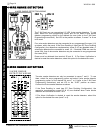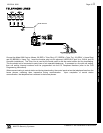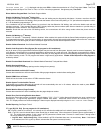
L NAPCO Security Systems
Freedom F-64 Installation Instructions
WI1501A 9/06
Page 17
GLOSSARY
The Freedom 64 control panel is capable of utilizing a combined total of 7 keypads and/or Touchpads, with a maximum of 4 Free-
dom Touchpads assigned to addresses 1-4. The balance can be any of NAPCO's Gemini "K Series" keypads assigned to ad-
dresses 5-7. (Note: Any Gemini "K Series" keypads installed in the system would possess limited functionality, and should only be
used to view system status). Displayed messages shown are for the Freedom Touchpads and Gemini "K Series" keypads. Please
refer to the F-64 Programming Manual (WI1502) for specific address numbers. Please note that the definitions in this glossary that
refer to "keypads" only apply to installations using Gemini "K Series" keypads on addresses 5-7.
Abort Delay (Do not program for UL Applications)
An Abort Delay is a delay period that allows cancellation of the central-station report by disarming the control panel before a report is
sent. If Enable CP-01 Limits is enabled, the Abort Delay is 30 seconds (which cannot be removed but can be adjusted to within the CP-
01 specification of 15-45 seconds). In addition, if an attempt is made to change the Abort Delay to less than 15 seconds or more than
45 seconds, the time will be entered as 30 seconds. If enable CP-01 Limits is NOT enabled, the factory delay time will be set at 30 sec-
onds, and can be deleted or increased to 255 seconds. See glossary entry Enable CP-01 Limits. Enable program zones for Abort
Delay and select an Abort Delay Time. Also, a Pre-Alarm Warning may be selected for zones allowing a Touchpad indication of alarm
with no alarm outputs or central station reporting for the duration of abort delay time.
AC Failure; AC-Fail Report Delay
If AC power is removed from the control panel, "AC POWER FAIL/E01-00 SERVICE" will display at the Touchpad with a flashing
"
SYS TBL" icon as a reminder and a pulsing sounder. Press RESET to silence the sounder; the "SYS TBL" icon reminder will remain
on and "SYSTEM READY" will appear in the display. If a User Code is entered within 5 minutes, the panel may be armed. After 5
minutes, the system trouble will again display.
AC Failure may be programmed to activate the Alarm Output, Pulsed Alarm Output, PGM1 Output, PGM2 Output, Relay Outputs and/
or report to a central station by selecting AC Fail Report Event Telco 1, AC Fail Report Restore Telco 1, AC Fail Report Event Telco 3,
AC Fail Report Restore Telco 3. The AC Trouble Fail Display, AC Fail Logging, and AC Fail Report to the central station will occur
immediately unless an AC Fail Report Delay is programmed.
Access Control; Access Control (Panel Access) on PGM2 Output; PGM2 Output Access Control Time; Panel Access
The following refers to the F-64PROG programmer only:
Note: The F-64 panel has not been evaluated by UL for compliance with UL294 (Access Control Systems).
The PGM2 Output can be programmed to activate for a programmable period of time (2 to 254 sec.). This allows it to be used for
access functions such as opening and closing a garage door, or remotely activating an electric door strike through an RB1000 relay.
This is achieved by programming a new Keyfob option, Access on PGM2 Output, into the Aux. 1 or Aux. 2 option locations on the
Wireless Keyfobs screen. This feature also requires a valid time to be entered into the PGM2 Output Access Control in the Time
Selection Screen.
If Access Control on PGM2 Output is selected, entering the Access Code (see User Code Programming in Easy Menu Driven Program
Mode) while disarmed will trip the panel's PGM2 Output. (This is commonly used to activate a door strike for the purposes of remotely
unlocking a door). Each keypad is individually selected for Panel Access. Also program PGM2 Output Access Control Timeout. Note:
Do not program the PGM2 Output as an output on alarm. Do not program Keyfob Chirp on PGM2, unless Enable Bell Output on RF
Arming is selected also.
Panel Access is selectable for any keypad 1–7 by selecting the appropriate Area Option of any User Code (see User Code
Programming in Easy Menu Driven Program Mode); select the Panel Access option for those keypad numbers (1–7) that are to
respond to the User Code. However, if the Access Option is programmed, the code will no longer function as an Arm/Disarm Code.
Entering a valid code at the keypad will cause the PGM2 output on panel to turn on for the programmed time. The RB1000 Relay may
be used to activate a door strike, and power to the door strike should be supplied from an independent power source.
Access Number for Outside Line (CS Receiver Telephone Number Access)
Some subscribers will have a telephone system that requires one digit to access an outside line. The first dial tone encountered (prior
to the access number) may have a frequency that is different from that of the accessed dial tone (440Hz). One or more 4-second Pre-
Dial Delay "D"s may be entered before any of the CS Receiver Telephone Numbers instead of a dial tone with frequency "E". See Pre-
Dial Delay; Telephone Numbers. (Note: The panel features automatic dial-tone detection and will normally not require any "E"s. To
disable this feature, see CS System Report Options in the Programming Instructions WI1502).
If the subscriber's system uses an access number, contact the telephone-equipment supplier to find out if a dial tone other than 440Hz
is received prior to dialing the access number. If the communicator must delay before dialing the access number instead of attempting
to recognize the dial tone, find out how many 4-second delays must be programmed.
Alarm on Day Zone See Day Zone
Alarm Outputs (See Wiring Diagram for UL requirements); Alarm Output Duration
The F-64 has three outputs: Alarm (Burg. & Fire), PGM1 and PGM2. The following table summarizes wiring for signaling an alarm in
typical installations. See Time Selection for timeout durations.
Glossary


















